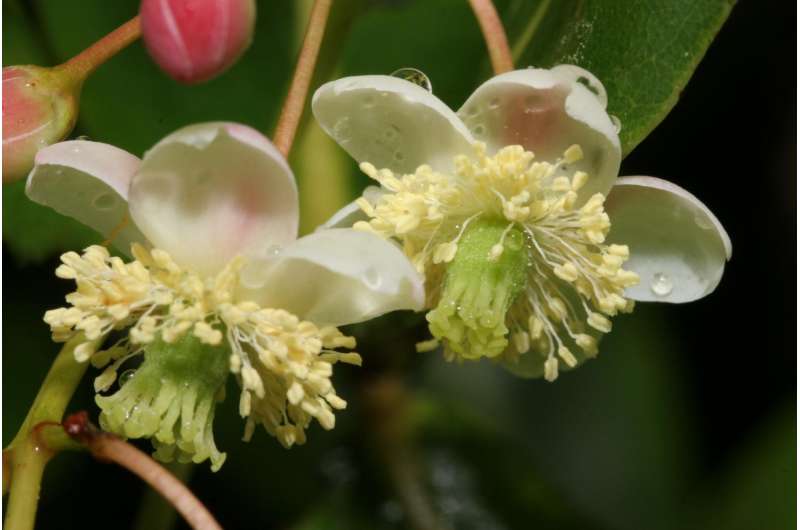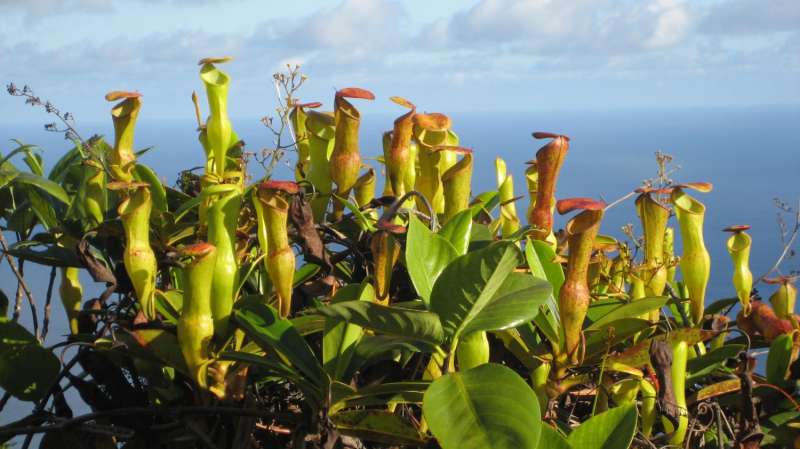Credit: Technische Universität Darmstadt
(Phys.org)—A team of researchers with members from the U.K., Germany, Denmark and The Seychelles has found that physically removing all of the invasive plants in a given area allows native plants and pollinators to regain at least some of their former vitality. In their paper published in the journal Nature, the team describes a study they carried out in the mountains in Seychelles, what they found, and what their results suggest about other efforts to improve the outlook for native plant species across the globe.
One of the hallmarks of the development of human civilization has been a massive increase in migration—people move from one part of the planet to another with relative ease. But that migration has led to problems as people often take plants or seeds with them, sometimes unintentionally, and that has led to plants growing in places nature never intended. The result is a huge increase in invasive species, quite often at the expense of native species. Now, as scientists wonder if order can be restored, a team of researchers has looked into whether native species are able to recover on their own if humans come in and take out the invaders.
To find out, the researchers ventured to the Seychelles, an archipelago in the Indian Ocean off the eastern coast of Africa. There, they picked out eight hectare-size mountaintops for study—each was subjected to a survey to learn what was living there and how well each plant species was doing. They found that invasive plants made up approximately a quarter of each plant population. They then removed all of the invasive species in four of the sites and left the others to continue as they had been.
Credit: Technische Universität Darmstadt
The researchers focused their efforts on pollen-producing plants, noting approximately 64 networks of them among the eight parcels of land—to gauge plant robustness, they measured fruit yield. After eight months of study, they found that at the sites where the invasive plants had been removed, the native plants produced 17.4 more flowers which led to an increase of 22.9 percent in pollinator visits and subsequently more fruit produced. They also found the numbers of pollinators grew as well, by approximately 21.6 percent.
The researchers suggest that removal of invasive plant species can lead to a rebound by native species, at least in some places.
More information: Christopher N. Kaiser-Bunbury et al. Ecosystem restoration strengthens pollination network resilience and function, Nature (2017). DOI: 10.1038/nature21071
Abstract
Land degradation results in declining biodiversity and the disruption of ecosystem functioning worldwide, particularly in the tropics. Vegetation restoration is a common tool used to mitigate these impacts and increasingly aims to restore ecosystem functions rather than species diversity. However, evidence from community experiments on the effect of restoration practices on ecosystem functions is scarce. Pollination is an important ecosystem function and the global decline in pollinators attenuates the resistance of natural areas and agro-environments to disturbances. Thus, the ability of pollination functions to resist or recover from disturbance (that is, the functional resilience) may be critical for ensuring a successful restoration process. Here we report the use of a community field experiment to investigate the effects of vegetation restoration, specifically the removal of exotic shrubs, on pollination. We analyse 64 plant–pollinator networks and the reproductive performance of the ten most abundant plant species across four restored and four unrestored, disturbed mountaintop communities. Ecosystem restoration resulted in a marked increase in pollinator species, visits to flowers and interaction diversity. Interactions in restored networks were more generalized than in unrestored networks, indicating a higher functional redundancy in restored communities. Shifts in interaction patterns had direct and positive effects on pollination, especially on the relative and total fruit production of native plants. Pollinator limitation was prevalent at unrestored sites only, where the proportion of flowers producing fruit increased with pollinator visitation, approaching the higher levels seen in restored plant communities. Our results show that vegetation restoration can improve pollination, suggesting that the degradation of ecosystem functions is at least partially reversible. The degree of recovery may depend on the state of degradation before restoration intervention and the proximity to pollinator source populations in the surrounding landscape. We demonstrate that network structure is a suitable indicator for pollination quality, highlighting the usefulness of interaction networks in environmental management.
Journal information: Nature
© 2017 Phys.org























